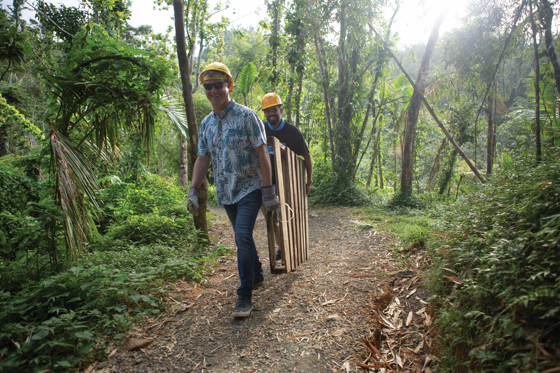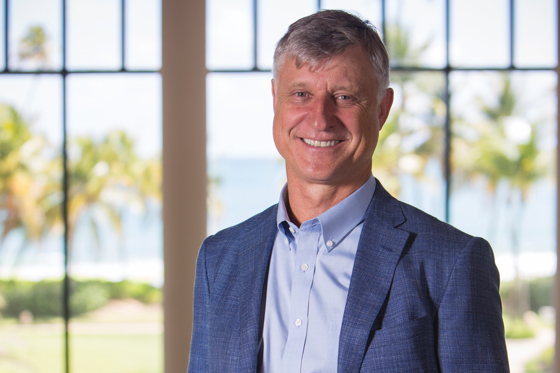It has been almost two years since Hurricane Maria struck the Caribbean, including Puerto Rico. Many lessons were learned during the recovery, including some by Wyndham Grand Rio Mar General Manager Nils Stolzlechner. As the next 2019 hurricane season looms, HOTELS reconnected with Stolzlechner to share how he rallied his staff, lived to welcome guests again, and slowly recover ADR. Here is his story.
Three days after Hurricane Maria struck Puerto Rico in September 2017, Wyndham Grand Rio Mar General Manager Nils Stolzlechner called his staff together and challenged them to reopen a pool and a bar within five days. The resort was hosting 178 stranded guests and, indeed, five days later visitors were sipping cocktails and floating in the pool.
“That was one of the most important things we did,” Stolzlechner said. “There was devastation, but our people saw that you can get back to normal pretty fast.”
As the stranded guests cleared out during the next three weeks, construction crews ramped up, rebuilding the lobby ceiling, renovated water-damaged rooms and replaced broken windows. The first paying guests checked in in February 1, 2018 — “a milestone for our employees,” Stolzlechner said.
The ordeal confirmed Stolzlechner’s instincts about leading in a crisis. “You need to have everyone understand the situation, what needs to get done,” he said. “The worst thing is to sit and do nothing.”

Stolzlechner was raised in the Austrian Alps, where his family operated an inn. After competing on the U.S. national ski jumping team during the 1980s, he found a career in hotel management and held positions at Westin, Omni and Wyndham Grand. He arrived at the Wyndham Grand Rio Mar Beach Resort & Spa three months before the epic storms bore down.
Riding out the storm
When Maria hit the morning of September 20, the staff was ready. “We had planned to wake guests at 4:30 a.m.,” he recalled. “By 2 a.m. we were experiencing winds of 100 mph and I couldn’t sleep.” Stolzlechner woke the staff, who rounded up the guests. By 3:15, everyone was accounted for and situated in a secure “ride-out” area.
By midafternoon, the winds had died down and staff began to assess damage. Water had ruined rooms and balconies on the top floor. Part of the lobby ceiling had caved in. Ballroom carpets were soaked. Fortunately, the hotel’s five generators had kicked in.
The next day, 40 staff members came to work, using chainsaws to cut through debris. Three days after the storm, more than 400 employees were clearing the beach and roads.
In normal times, there’s room for democracy — allowing for staff input on how tasks should be accomplished, Stolzlechner said. “Now, it was a dictatorship. There was no time for discussion. But if you do it right, people follow because they trust you.”

As the airport reopened and guests cleared out, relief workers poured in. A haggard fire chief from New York arrived one day. “Do you have 100 rooms left?” Stolzlechner recalled him asking. The hotel waived the normal credit checks and ushered them in. Later, members of a U.S. Army unit came through.
The contractors paid a per diem rate mandated by the Federal Emergency Management Agency and ended up spending 16,000 room nights at the resort. The Wyndham donated US$16,000 (US$1 for each room night) for the recovery of the neighboring El Yunque National Rainforest.
The hotel paid its 500 employees for two full months, whether or not they worked. About 300 continued full- or part-time. “Nils was intensely committed to reopening the resort to avoid having to lay people off,” said Brad Dean, CEO of the tourism marketing group Discover Puerto Rico.
There was work for housekeepers and F&B staff, but some layoffs were necessary. With the resort closed, there was little need for reservation, front office and operations managers. Some families, Stolzlechner said, left the island.
Then there was the problem of convincing visitors that the resort was open for business. Stolzlechner installed a webcam to show meeting planners that the hotel was in full operation. “Nils sees things from the consumer’s point of view,” Dean said.
In December 2017, Stolzlechner invited two representatives of the Kentucky Highway Construction Workers to view progress; the group was threatening to cancel its already-booked February 1 conference. “Give us a chance,” he told them. “We’ll be ready for you.” The conference attendees — those first paying guests — checked in as planned.
Compared to early 2018, ADR had seen 30% growth, to US$264.18 by March 2019. And Puerto Rico continues to rebound nicely with Discover Puerto Rico, the Island’s first-ever Destination Marketing Organization, announcing that January – April 2019 occupancy spending reached US$373.6 million, the highest in the past eight years, and an increase of 12.4% when compared to 2017 pre-hurricane Maria levels. In addition, Puerto Rico Governor Ricardo Rosselló is trying to entice investors to the island’s hotel sector with a US$120 million deal and new tax credits.
But Stolzlechner, as late of March, was still frustrated when he traveled and met people who believed Puerto Rico was still down on its heels. “People look at me and say, ‘Oh my God, are you guys all right?’”
“Do I look all right?” he answered.
